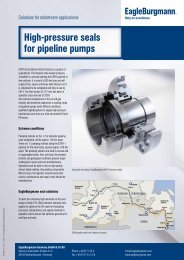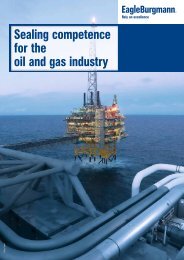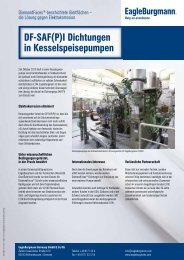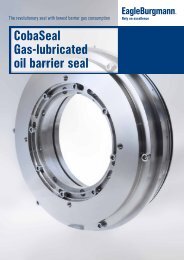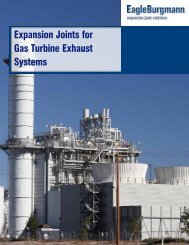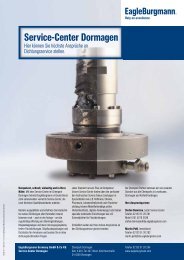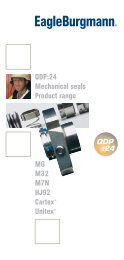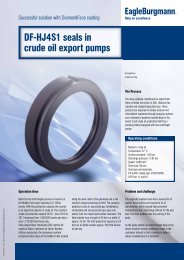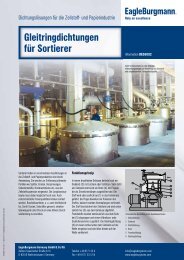Emergency Services - EagleBurgmann
Emergency Services - EagleBurgmann
Emergency Services - EagleBurgmann
You also want an ePaper? Increase the reach of your titles
YUMPU automatically turns print PDFs into web optimized ePapers that Google loves.
Types of FCCU<br />
Expansion Joints<br />
• Hot Wall<br />
• Cold Wall<br />
• Unlined<br />
Types of FCCU Expansion Joints<br />
There are three major types of FCCU<br />
expansion joints: hot wall, cold wall,<br />
and unlined.<br />
• Hot Wall<br />
These joints usually have some form<br />
of abrasion resistant lining, comprised<br />
of hexmesh and castable material or<br />
refractory such as Resco AA-22®, a<br />
common abrasion resistant material.<br />
The lining is designed to withstand<br />
the abrasion from the catalyst flowing<br />
through the unit in service. The lining<br />
requires a thermal dry out after<br />
installation.<br />
The lining is not intended to be used<br />
as a thermal barrier; therefore the<br />
shell temperatures of the expansion<br />
joint rise above the allowable temperatures<br />
for normal carbon steels. The<br />
joint shells are normally manufactured<br />
from various Chrome Moly alloys and<br />
stainless steels. Due to their trademark<br />
conical sections near the bellows area,<br />
hot wall expansion joints are easily visible.<br />
The oversize bellows allows for a<br />
smooth flow across the bellows area<br />
using a straight through liner arrangement.<br />
Hexmesh before and after castable material<br />
has been installed.<br />
• Cold Wall<br />
Cold wall joints as their name suggests<br />
are refractory lined to ensure the shell<br />
wall temperatures does not exceed<br />
650°F/343°C.<br />
The lining consists of stainless steel anchors<br />
and a high-density vibrocast refractory<br />
material. Depending on service<br />
condition, the thickness ranges from 4”<br />
to 8” (10 cm to 20 cm). Again, the final<br />
process involves a thermal dry out before<br />
operational service.<br />
The photograph above shows the stainless<br />
steel anchors prior to vibrocasting<br />
the refractory. The internal surface will<br />
be blasted to near white and casting<br />
forms fitted internally to hold the wet<br />
refractory in place until it cures. The finished<br />
unit is shown here. This expansion<br />
joint has been thermally dried and the<br />
lining<br />
process is<br />
now<br />
complete.<br />
After the<br />
unit is<br />
installed<br />
the<br />
remaining<br />
refractory<br />
will be<br />
added onsite.<br />
5



